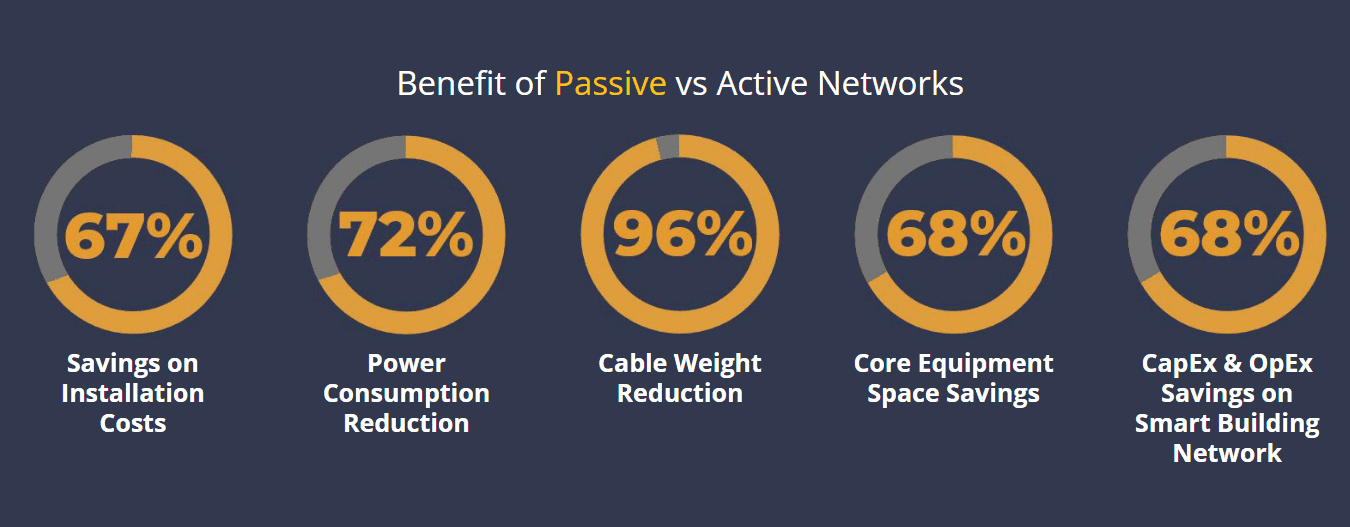Benefits of PON for your In-Building Converged Network
When considering the implementation of a converged network for your building, there are currently two technology options that stand out: Passive Optical Network (PON) and Active Ethernet. Both solutions have their merits, but understanding the key differences between the two options can help you make an informed decision. In a future post, we will write about a third technology option using private 5G wireless technology and how suitable it is for use as a base building network.
Simplified Architecture Leads to Lower Cost of Equipment and Lower Cost of Management
PON offers a simplified architecture compared to Active Ethernet, making initial deployment, management and troubleshooting easier. With only two layers (core and edge) instead of the three-layer structure (core, distribution, and edge) of Active Ethernet, PON requires fewer active components, reducing installation costs. It also means that is simpler to identify and resolve network issues.
Easier to Scale Up to Accommodate More Devices
PON’s scalability is more efficient and can easily scale up the number of ports required. Unlike the traditional active ethernet network which still predominantly run on copper lines, fibre-based PON is all optical and can split light, allowing for the addition of more ports without the need for extensive cabling or additional core infrastructure. This means that the network can be efficiently expanded without incurring high costs. For smaller properties with low number of devices, active ethernet would be more cost-effective due to lower cost for the individual devices. PON’s flexibility allows for a more cost-effective and streamlined expansion of network ports as more building systems and devices are added.
Lower Total Cost of Ownership with Longer Refresh Cycles
Active Ethernet often requires regular equipment refresh cycles, approximately every 5 to 7 years, to maintain vendor support. This is especially important when it comes to addressing security vulnerabilities. This frequent replacement of core equipment can result in substantial costs over time. On the other hand, PON is designed for long-term use, with a lifespan of at least 10 to 15 years before any end-of-life announcements.
Due to this extended lifespan, the Total Cost of Ownership (TCO) of PON solutions is typically about one-third of the cost of Active Ethernet systems. In the long run, PON proves to be a more economical choice as you avoid the need for frequent hardware replacements.

Network Security Tailored to Building Systems
In sensitive corporate IT environments, Active Ethernet’s two-way encryption capabilities is the best solution. However, for transmitting building operational technology (OT) system data, such as HVAC temperature readings and non-confidential information, PON is the ideal choice.
For example, the data passing through PON may include temperature data that loses its value after a certain time period. While historical data is valuable for building optimization, it does not require the same level of compliance-driven protection as sensitive data.
PON offers the appropriate level of security for the type of data it handles. When combined with additional security measures like firewalls and application-level encryption, PON can offer a secure and cost-effective solution for various base building network applications.
Proven Technology and Industry Adoption
While the concept of employing PON for base building networks might seem novel, its technological roots run deep. Telecom carriers have embraced PON for decades to transmit signals across extensive distances, underpinning its robust reliability and stability. PON’s track record across diverse applications, including residential markets, underscores its versatility and effectiveness.
Moreover, PON is purposefully designed to accommodate the unique needs of building environments. Unlike traditional Active Ethernet, which might require additional software components to address specific building demands, PON boasts a tailored software stack that efficiently manages building-specific functions without unnecessary complexity.
Choose the Right Infrastructure for the Converged Network for your Building
The decision to go with PON or Active Ethernet for your base building network depends on your specific needs and priorities. For multi-building portfolios with long-term considerations, security and scalability concerns, PON emerges as a compelling choice. Its simplicity, security level, and impressive cost savings make it a worthy alternative to traditional active ethernet solutions. By understanding the benefits of PON, you can make an informed decision that aligns with your base building network goals and budgetary constraints. Contact Andorix to learn more about our Managed PON solution and why you should consider outsourcing the converged network solution for your commercial and residential building portfolio.







